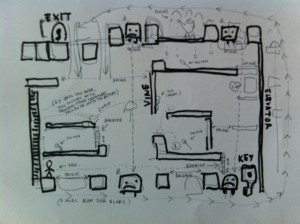[Welcome to day 90 of Man Vs. Donkey Kong. Why am I playing through all 101 stages of Donkey Kong (Game Boy, 1994) in 101 days? Go back to the beginning to find out. All caught up? Good. Proceed.]
Though I fancied myself an artist and a storyteller (I’d written my first book in the third grade—a biting, mostly illustrated satire titled Planet of the Grapes), I actually did surprisingly well in math, too. Sure, I was marginally intimidated by instructions like, “To start using VICMON type SYS24576 or SYS6*4096, and then press the RETURN key.” But considering my comfort level with equations, X and Y axises, and prime numbers, I wasn’t completely deterred. (In retrospect, I probably should have been.) The same way that I’d learned how to say “Excuse me, sir, where is the hotel?” in French, or learned to steer clear of my father on days when he came home from work covered in concrete dust—pouring concrete always put him in the worst of moods—I assumed I could eventually figure out machine code, too. I simply needed to apply myself.
The next day I went to the school library, hoping to locate the primary texts listed in the Machine Monitor cartridge’s instruction book, like the MOS 6502 Programming Manuals (manuals plural), and the VIC Programmers’ Reference Guide. While the librarian couldn’t find the exact texts I was looking for, he did find some computer-related manuals in another school district. Because they were “special-order” books, I wouldn’t be allowed to take them out of the library. So I began spending my lunch hours in the library poring over these sacred texts, trying to make sense of them, while scribbling incoherent notes into a notebook and doing my best to stave off sleep.
Many of the computer programming manuals the librarian had located weren’t specifically related to the VIC-20, or Machine Code. They were for a language called BASIC, and designed for a line of older-model Commodore computers called PETs. No matter. I had to start somewhere. So what I did was this: I’d sit there and read the same paragraph or sentence over and over again—”A reset signal may also be generated without power-on by a connection on the memory expansion connector; A reset signal may also be generated without power-on by a connection the memory expansion connector”—telling myself that if I read it enough times, it would eventually reveal its meaning to me.
Sometimes I understood the sentences right away. But most of the time, sentences would actually degenerate before my eyes the more times I read them. For example, “An array is a group or table of values or strings referenced by the same variable name” became “An arid is a grape of value strings referring to the same warble dame.” And on a third reading, it became, “A group of strings ate grapes named wobble bane.” I spent nearly a week’s worth of lunch hours puzzle over this—”X+Y<(T-1)/Z”—and, to this day, I still have no idea what it means.
The deeper I dug into the books, the more the labyrinth in my brain kept sprawling in all directions. It would be an understatement to say that I had severely underestimated the size and scope of this challenge. As I always did in difficult moments, my mind drifted to Evel Knieval and his ridiculous attempt to jump Snake River Canyon in his ridiculous rocket-powered motorcycle that he called a “Skycycle.” His parachute had misfired during launch, which made for terrible television—my brother and I were dejected as we watched the parachute bloom prematurely and he and the Skycycle lazily drifted into the canyon—but was, in retrospect, probably a blessing because Evel Knieval likely would have killed himself that day. As I continued to hurl myself at these impenetrable books, I wondered if this is what Evel Knieval felt like as he descended helplessly to the canyon floor.
One day I ate lunch in the cafeteria like a normal kid again, telling myself that the next day I’d go back to the library and my computer books. But I never did. All of my pre-production work on Turtle!—my notes, my box cover sketches, my marketing plans, everything—eventually went into a drawer at home, where they stayed until my parents sold the house and moved to Florida in 2004. (The notes likely went into the trash then.) The Machine Code Monitor cartridge became a kind of ominous object, not unlike that silver Rubik’s Cube in the movie Hellraiser. Like the cube, I’d played with the Machine Code Monitor cartridge, hoping to unlock its mysteries. Instead, I’d wound up bringing all sorts of unexpected pain upon myself.
Several years later, during one my parents’ annual mid-summer garage sales, a boy offered $40 for the VIC-20 and all of its accoutrements. (My parents were asking $50.) My mom came into the house and asked if I’d come outside and answered the boy’s questions. “Can you make your own videogames with this computer?” he asked me excitedly. I told him that he could. “The key is this,” I said, reaching into the bin of old VIC-10 peripherals and pulling out the dust covered Machine Code Monitor cart. This bit of news sent the boy over the moon. After the transaction was completed, I nearly stopped him and his parents as they reversed their car out of our driveway. You don’t want that thing! I wanted to say. It’ll destroy you, I tell you! Also, I wanted to stop them because I still had a nostalgic attachment to the VIC-20, and it seemed foolish to let it go for $40.
But it was too late. They were gone. “Here, this belongs to you,” my mother said, putting the $40 into my hand. Forty dollars was a lot of money to me at the time. I reluctantly stuffed the money into my pocket. A few weeks later, I’d blow all the money on cut-rate beer while stupidly trying to impress my freshmen roommates during my first week of college.

Now, gird your loins for stage 8-14. Today’s stage will let you know, in no uncertain terms, that you’re now in the homestretch of the game. Yes, this is, without a doubt, the biggest, most complex stage we’ve encountered so far. It sprawls across four—yes, I said four—gameplay screens. At the top left of the stage is the exit door. In the bottom righthand corner is the key. At the very bottom of the stage is, apparently, lava, even though it looks eerily similar to water. I attempted to jump into it, figuring that I could simply swim my was across the bottom of the stage to the key. Guess what? Dead.
Now, I could attempt to explain this stage to you in painstaking detail. But I don’t think that would 1. be much fun to read, or 2. do you any favors. The overall goal of the stage is to get the pair of frowning, bipedal stone creatures—see them there at the very top?—to fall from the topmost tier of the stage all the way down to the bottom of the stage, where you can use them to traverse the lava (they are stones, which makes them impervious to lava) (duh). You can accomplish this by pushing and pulling the three switches in the stage. The three switches make various bridges extend and retract, or, in some cases, make barriers rise and fall. Keep fooling with them, and eventually, that pair of frowning creatures will be jostled all the way down into the lava.
Also worth noting: there’s a seed-spraying exotic plant on the upper tier, which releases four seeds simultaneously, all four of which float downward through the stage like tiny, leaking (but deadly) balloons. Though they’re easy enough to avoid, they can be a nuisance, so keep an eye out for them.
My advice: trust your Donkey Kong instincts today. No kidding. You know this game inside and out by now. The same way that Clarice Starling comes to understand the minds of serial killers in the hit movie The Silence of the Lambs, you now understand how the developers’ minds work at this point. You know what their appetites and desires are. You’ve seen their entire bag of tricks. And you know—trust me, you know—what they’re going to do to you next. And if you get stuck, refer to the detailed map that I drew for you. No, it’s not a perfect facsimile of the stage—because of its scope, I had trouble recalling the details in a few of the areas—but it does give you the broad strokes.
Once the two frowning stone creatures have fallen to the bottom and are romping about in the lava, head for the key (bounding across the heads of the frowners), grab it, then ride the elevator on the righthand side all the way to the top of the stage. Take care to avoid the seeds from the pesky seed-spitting plant. In fact, if you’re feeling strong, hurl the key at the plant, and send it straight to videogame hell, where it belongs.
Then make your way to the exit door, feeling good about the fact that you may have just completed the best, most challenging stage that this entire game has to offer. We’ll see what stage 91 has in store for us tomorrow.




I wonder if that kid who bought Scott’s VIC-20 is out there, right now, penning a series of blog posts about his past dreams of making his own game and how he eventually got screwed over by a kid at a garage sale. 🙂